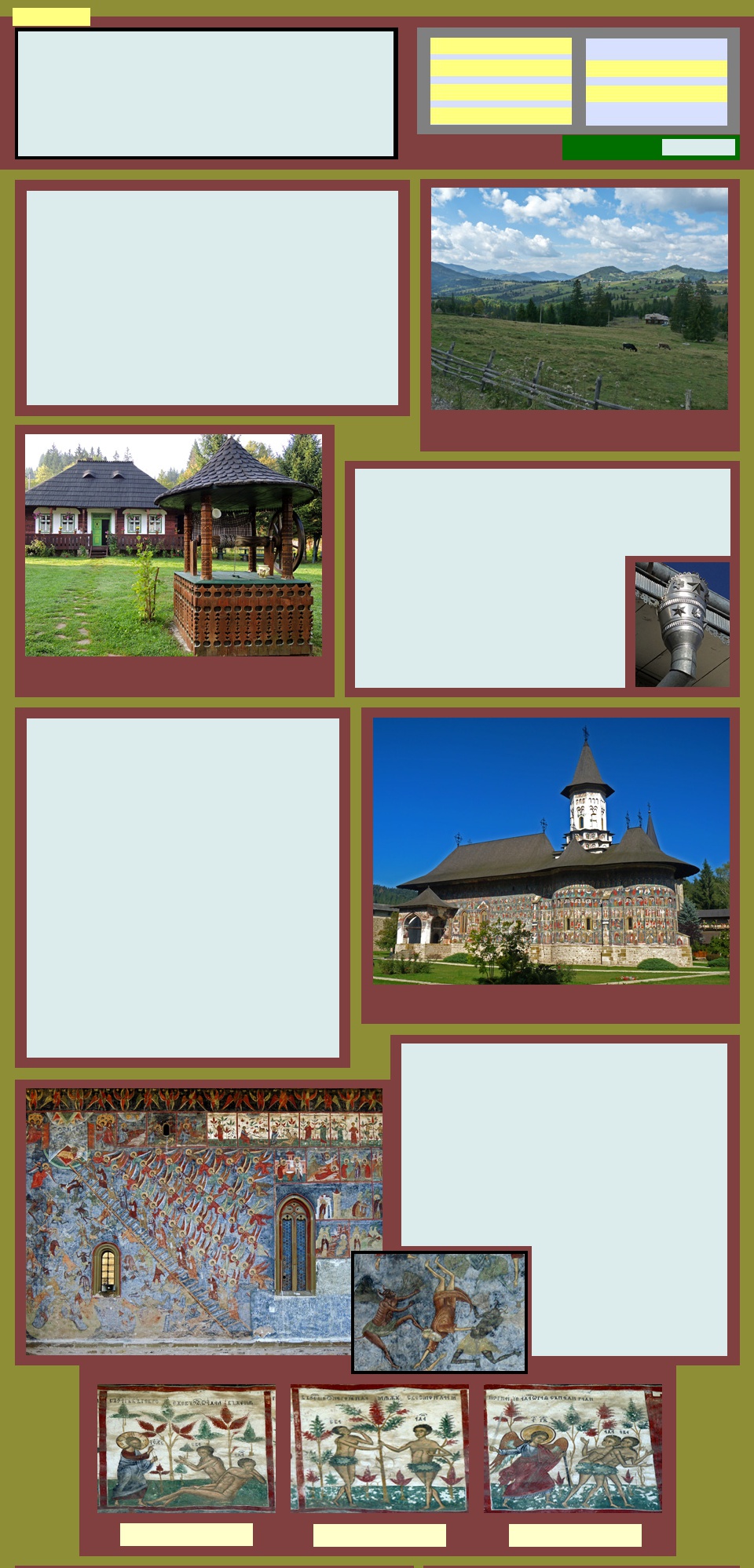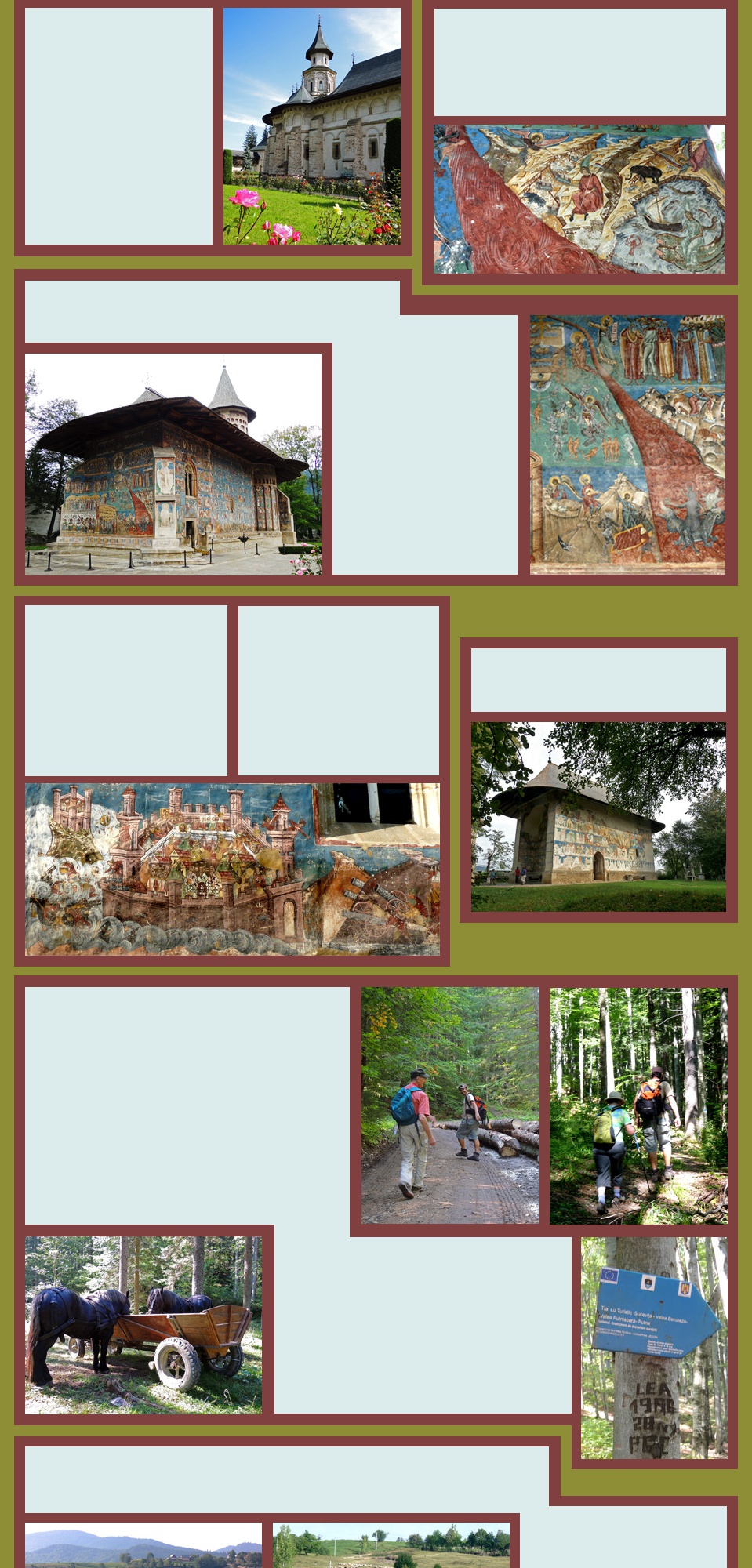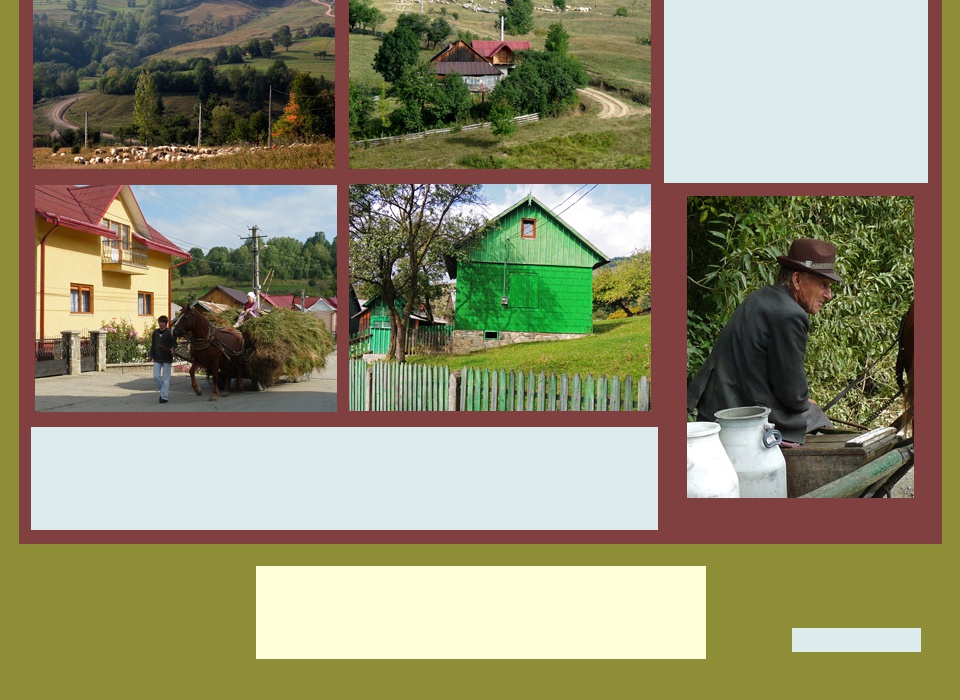View pictures of
Bucovina
Painted Monasteries, Walks and Villages
Bucovina, in the north western corner of present day Moldavia is more
correctly known as Southern Bucovina. The northern part was retained by the
Soviet Union in 1940 and is now part of Ukraine, one of the outcomes of the
division of spoils that split communities and families.
It took a full day to drive from Maramures, across the Carpathian mountains,
to Bucovina. This was a spectacular and exhilarating drive, crossing over five
passes and discovering valleys where clear mountain streams flowed. One
of the passes, the Tihutza Pass, was appropriated by Bram Stoker as the
Borgo Pass in his Dracula story. There is a Dracula Hotel and, on this
Sunday, a garlic festival which caused a three kilometre traffic jam.
Alongside the road people were selling buckets of yummy looking
mushrooms, and sometimes berries. Everywhere there were apple trees
laden with fruit. Horses and carts trotted along the road and huge quantities
of timber were stockpiled in all the towns we passed through.
A string of small villages have sprung up around the Bucovina monasteries.
We were based in Sucevita where we had a spacious room in a traditional
house, one of a cluster that was grouped round lawns and fruit trees. There
was a big bed with individual duvets, a blue ceramic stove, hand stitched
fabrics hanging on the walls, carpets round the walls and all over the floor. We
had to leave our shoes outside and it was just lovely.
The domestic architecture of the villages was now
quite different. The houses were still simple wooden
structures but their facades were often painted in
bright colours and always elaborately decorated.
Sometimes they also featured ornate metal guttering
and downpipes. Most houses had a well in the garden
with a pretty little structure built over it. Picket fences
or decorative metal structures enclosed well
maintained gardens.
Villages in Bucovina
The Bucovina monasteries are remarkable artistic, historic and
religious masterpieces. As a group they are listed on UNESCO's
list of World Historic sites. They were built from the late 15th
century to the late 16th century and, inspired by Byzantine art,
their exterior walls are covered in detailed and elegant fresco
paintings. The frescoes are exceptionally well preserved and
restoration has been minimal and sympathetic. The interiors
also are highly decorative and we were able to watch intricate
restoration work being carried out.
Constructed as fortresses during the times of Ottoman
invasions the monasteries gave protection to armies and the
local peasants. The paintings, illustrating historic and religious
stories, were undertaken for the edification and entertainment of
those sheltering within the monastery.
There are 22 painted churches, eight are in the UNESCO listing
and we visited six of them. They are all very active places of
religious devotion, still enclosed within their fortress walls. The
churches are surrounded by manicured gardens full of colourful
roses.
Volumes have been written about these wonderful places and a
detailed examination of every image in every panel on every wall
is almost a lifetime's study. We could only try to take it all in and
select a small number to fully appreciate.
The Monasteries
This was the last of the monasteries to be built, between 1582
and 1601. Some say it is the finest. It was the first that we
visited and we were astonished and amazed by our first sight
of a blue wall covered with angels.
Sucevita Monastery
This is the so-called Ladder of Virtues or Ladder to Paradise.
A painted ladder cuts diagonally across the wall and people
are climbing up towards Paradise. Above the ladder are the
angels and below are nasty demons (in the detail) trying to
pull the climbers down into the underworld.
Above this masterpiece (top right) is a 'comic strip' depicting
the story of the creation - a series of panels which move from
the Creation to the expulsion of Adam and Eve from the
Garden of Eden.
The other walls are also richly
decorated but this first impression has
left a lasting impact. Inside the church
the brilliant colours of recently restored
paintings could only be glimpsed
through walls of scaffolding.
God creates Eve
Eve eats the fruit
Expulsion
Putna was built between 1466 and
1481. There are no paintings on its
external walls but the interior walls
are covered with stylised, almost
modern, Byzantine paintings
gleaming after their recent
restoration. Still an active
monastery, it is cherished by
Romanians as the burial place of
Stefan the Great, the heroic and
much loved Prince of Moldavia who
lived from 1457-1504. He claimed to
have fought 36 battles against
Hungary, Poland and the Ottoman
Empire, winning all but two. To mark
these victories he built many
churches and monasteries.
The monastery was founded in 1530 and its decoration
dates from 1535. Here the frescoes are predominantly red
and we encountered a remarkable Last Judgement featuring
a dramatic river of fire in which unfortunate sinners are
struggling. Angels, demons, wild animals and fish are also
part of the story. On one of the walls is a faded
representation of the Siege of Constantinople in 1453.
With perhaps the best preserved of all the frescoes, this was our favourite.
Known as the "Sistine Chapel of the East", it was founded in 1487 by Stefan
the Great to celebrate one of his victories over the Turks.
Putna Monastery
Humor Monastery
Voronet Monastery
Built in 1532, its frescoes were
completed in 1537. A remarkable
feature here was another Siege of
Constantinople, this one in superb
condition. We see Turkish cannon
blasting towards the walls and turrets of
the city, spirals of smoke, archers
ineffectively shooting from the walls and
bodies falling all over the place.
The cannon were supplied to the Turks
by an mercenary Hungarian knight.
According to the Romania Tourism
website the "Siege of Constantinople"
frescoes were inspired by a poem
dedicated to the Virgin Mary who
saved the city from a Persian attack in
A.D. 626.
The actual fall of Constantinople
(1453) was a calamitous event for the
eastern Europe of the day and may
account for some of the apocalyptic
'rivers of fire' frecoes elsewhere.
Moldovita Monastery
Abore Church
This is a simple and very small church built in 1503.
It was painted four decades later but has not retained
the intensity of some of the others. We loved it for its
quiet simplicity.
The frescoes were added 60
years later, the highlight being
one whole wall on which is
depicted a colourful Last
Judgement. Again the river of
fire runs through the painting,
the sainted goodies line up on
one side and those about to
be thrown into the fire on the
other.
The intense blue of these
walls that has retained its
colour for 500 years is called
"Voronet Blue"
Walking in Bucovina
Between visiting churches we did some great walks
from village to village, climbing over rolling hills and
crossing through dense forests.
Sucevita to Putna
The first walk was through the forests, starting on the outskirts of
Sucevita and finishing near Putna along a route that was sign
posted in a rudimentary fashion. Again Dan left us at the start and
found us at the end of the trail. It was a pleasant walk climbing
over a small mountain from one valley to another and enjoying the
valley roads on either side.
We started on a vehicle track that ran alongside a lazy stream and
climbed slowly, observing more and more forestry activity. First
there were stacks of logs and gradually the road became very
muddy till we left it and climbed up to a shady forest track. There
was a continual buzz of chainsaws in the air.
Reaching the crest, we walked along a ridgeline with glimpses
of the distant valley and after a while slid down a steep track to
the road in the next valley. From here it was an easy walk
along another stream. We stopped for lunch on a pile of logs
where we were joined by some forest workers and their two
strong Polish horses, bought on the Internet, said their proud
owner.
The job of these sturdy horses was to pull the fallen logs out of
the forest to where the heavy machinery would take over and
make more mud. On the road through the valley there were
forestry shelters, hamlets and farmhouses and, always, horses
and carts trotting along with the business of the day.
Through the Polish villages towards Humor
A significant population of Polish people live in several villages in the region of Bucovina near Sucevita. They are
descended from miners brought here in the 18th century and a more recent wave of immigration in the early
19th century when the region was part of the Austro Hungarian empire. The three main villages are Plesza,
Nowy Solonutu, Pojana Mikuli.
One of our most enjoyable walks was
through these villages and the hilly
country that hid them from view.
Dan dropped us at a crossroads on a
main road and we set off along a stony
minor road winding up and down a
couple of hills with farmland and forests
on either side of the road.
A few hours later Dan met us at the other end and we were off to see another monastery.
It had been the monasteries that had brought us to Romania and they overwhelmingly met our
expectations. But equally delightful was the countryside and the picturesque villages, all different and quite
unique to their particular geographical area. From here it was to be different again as we crossed the
mountains again to Transylvania and the Saxon villages
We walked through two of the villages
and in one of them stopped to chat to a
Polish babushka. We passed lots of
horses and carts and were carried away
photographing the picturesque houses in
the villages.
In other pages are descriptions of our experiences in
Near Tihutza Pass
The cottage in Sucevita
Sucevita Monastery



